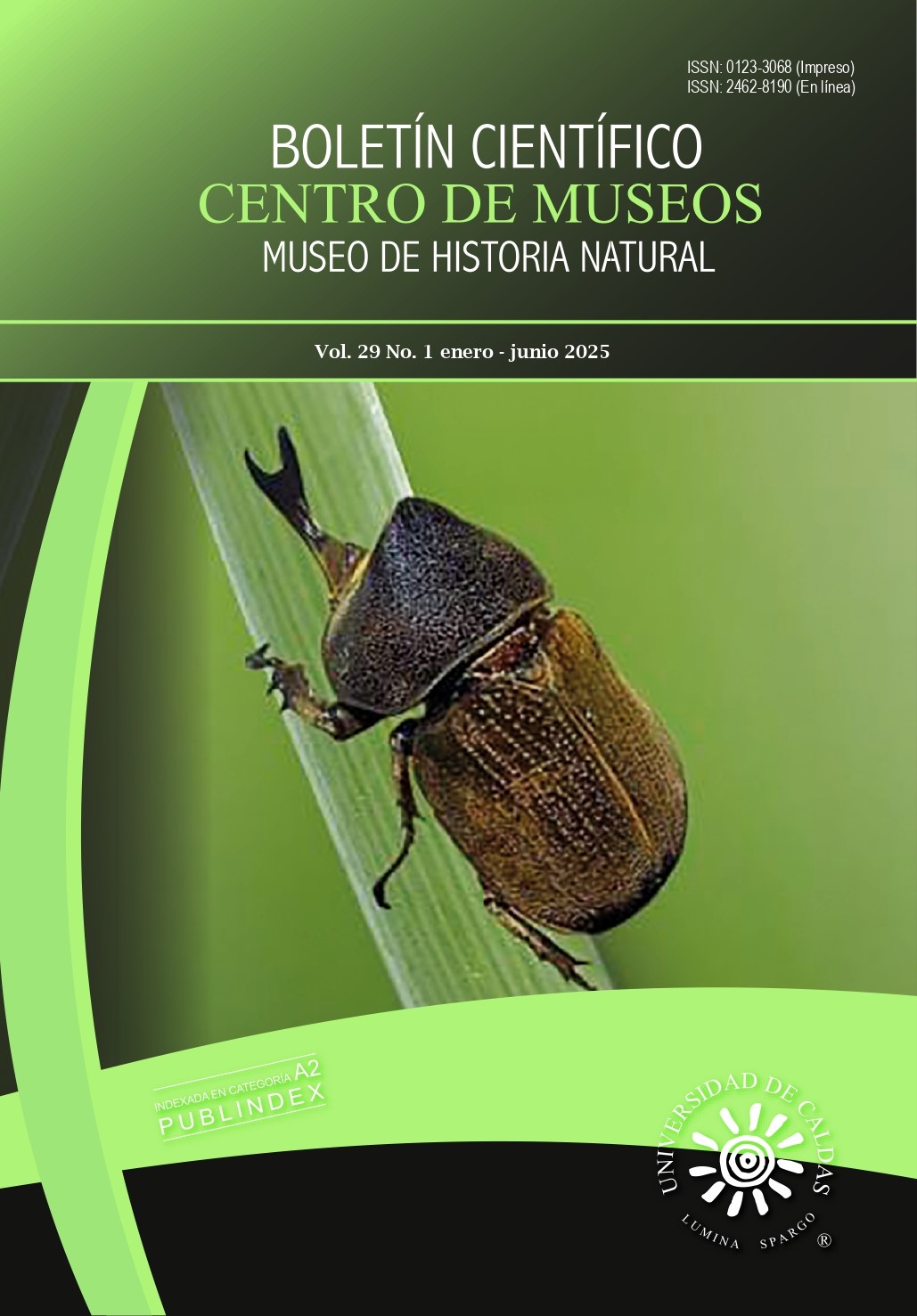Authors
Abstract
Endemic species are restricted to specific geographic regions or ecological zones characteristic of a given ecosystem. The páramo ecosystem is considered a center of endemism, with at least 60% of its flora being endemic. Adaptive strategies of these species to changing environmental conditions may relate to variations in physiological traits, influencing growth, reproduction, and survival. This study evaluated functional physiological traits linked to growth capacity and desiccation resistance in páramo-restricted and widely distributed plants (endemic vs.non-endemic). Research was conducted in Las Ovejas Páramo (Nariño, Colombia), with 14 species: six endemic and eight non-endemic. Measured traits included specific leaf area (SLA), foliar nitrogen and phosphorus content (N, P), desiccation resistance (% recovery of Fv/Fm), and electron transport rate (ETR). Results showed statistically significant differences in all variables, with higher values in endemic species, suggesting thinner or less dense leaves, greater resource-use efficiency, higher photosynthetic capacity, and enhanced desiccation resistance. Non-endemic species exhibited conservative traits, with lower SLA and nutrient concentrations, likely reflecting greater carbon investment in durable structures, reduced herbivory, and increased leaf longevity. Endemic and non-endemic species respond differentially to páramo environmental pressures, with endemics displaying traits better suited to this ecosystem.
References
Continuum of Photoprotection. En B. Demmig-Adams, W. W. Adams y A. K. Mattoo (Eds.), Photoprotection, Photoinhibition,
Gene Regulation, and Environment (Vol. 21, pp. 49-64). Springer. https://doi.org/10.1007/1-4020-3579-9_5
Alpert, P. (2000). The Discovery, Scope, and Puzzle of Desiccation Tolerance in Plants. Plant Ecology, 151(1), 5-17. https://doi.
org/10.1023/A:1026513800380
Arzac, A., Chacón-Moreno, E., Llambí, L. D., & Dulhoste, R. (2011). Distribución de formas de vida de plantas en el límite superior
del Ecotono bosque Páramo en Los Andes Tropicales. Ecotrópicos, 24, 26-46.
Baker, N. R. (2008). Chlorophyll Fluorescence: A Probe of Photosynthesis In Vivo. Annual Review of Plant Biology, 59(1), 89–113.
doi:10.1146/annurev.arplant.59.032607.092759.
Baruch, Z. y Goldstein, G. (1999). Leaf Construction Cost, Nutrient Concentration, and Net CO2 Assimilation of Native and
Invasive Species in Hawaii. Oecologia, 121(2), 183-92. https://doi.org/10.1007/s004420050920
Behroozian, M., Ejtehadi, H., Memariani, F., Pierce, S. y Mesdaghi, M. (2020). Are endemic species necessarily ecological specialists?
Functional variability and niche differentiation of two threatened Dianthus species in the montane steppes of northeastern Iran.
Scientific reports, 10(1), 1-11.
Bernal, R., S. R. Gradstein y M. Celis (eds.). 2015. Catálogo de plantas y líquenes de Colombia. Instituto de Ciencias Naturales,
Universidad Nacional de Colombia. Bogotá, Colombia. http://catalogoplantasdecolombia.unal.edu.co/es/
Bover, P. y Alcover, J. A. (2000). Extreme Insular Evolution in Myottagus Baleaficus Bate 1909 (Artiodactyla, Caprinae). Tropics, 10(1), 89-201.
Cabrera, M., & Ramírez, W. (Eds.). (2014). Restauración ecológica de los páramos de Colombia: Transformación y herramientas para su
conservación (pp. 296-296). Ministerio de Ambiente y Desarrollo Sostenible, Instituto de Investigación de Recursos Biológicos
Alexander von Humboldt.
CORPONARIÑO – Universidad de Nariño, 2009., Diagnostico Físico Ambiental del Páramo de Las Ovejas – Tauso.
Dulhoste, R. (2010). Respuestas ecofisiológicas de plantas del limite arbóreo (selva nublada–páramo) al estrés térmico, hídrico y lumínico en los
Andes Venezolanos. Merida, Venezuela: Instituto de Ciencias Ambientales y Ecológicas. Departamento de Biología. Universidad de los Andes.
Durand, L. Z. y Goldstein, G. (2001). Photo-Synthesis, Photoinhibition, and Nitrogen Use Efficiency in Native and Invasive Tree
Ferns in Hawaii. Oecologia, 126(3), 345-54. https://doi.org/10.1007/s004420000535
Fernández-Alonso, J. L. (2002). Algunos patrones de distribución y endemismo en plantas vasculares de los páramos de Colombia.
En Congreso Mundial de Páramos, Memorias Tomo I (pp. 213-229). http://www.banrepcultural.org/blaavirtual/geografia/
congresoparamo/algunos-patrones.pdf
Flexas, J., Ribas-Carbó, M., Díaz-Espejo, A., Galmes, J. y Medrano, H. (2008). Mesophyll Conductance to CO2: Current Knowledge
and Future Prospects. Plant, Cell and Environment, 31(5), 602-21. https://doi.org/10.1111/j.1365-3040.2007.01757.x
Franks, P. J. y Farquhar, G. D. (2007). The Mechanical Diversity of Stomata and Its Significance in Gas-Exchange Control. Plant
Physiology, 143(1), 78-87. https://doi.org/10.1104/pp.106.089367
Gaff, D. F. y Oliver, M. (2013). The evolution of desiccation tolerance in angiosperm plants: a rare yet common phenomenon.
Functional Plant Biology, 40(4), 315-328.
Galmes, J., Conesa, M. A., Cifre, J., Gulías, J., Medrano, H., Ribas-Carbó, M. y Flexas, J. (2010). Ecofisiología de las plantas
endémicas de las Islas Baleares en el contexto Mediterráneo. Ecosistemas, 19(1), 10-23.
Gulías, J., Flexas, J., Mus, M., Cifre, J., Lefi, E. y Medrano, H. (2003). Relationship between Maximum Leaf Photosynthesis,
Nitrogen Content and Specific Leaf Area in Balearic Endemic and Non-Endemic Mediterranean Species. Annals of Botany,92(2), 215-22. https://doi.org/10.1093/aob/mcg123
Hassiotou, F., Evans, J. R., Ludwig, M. y Veneklaas, E. J. (2009). Stomatal crypts may facilitate diffusion of CO2 to adaxial mesophyll
cells in thick sclerophylls. Plant, Cell & Environment, 32(11), 1596-1611. https://doi.org/10.1111/j.1365-3040.2009.02024.x
Hoekstra, F. A., Golovina, E. A. y Buitink, J. (2001). Mechanisms of plant desiccation tolerance. Trends in Plant Science, 6(9), 431-
438. https://doi.org/10.1016/s1360-1385(01)02052-0
Huang, G., Zhang, Q., Wei, X., Peng, S. y Li, Y. (2017). Nitrogen Can Alleviate the Inhibition of Photosynthesis Caused by High Temperature
Stress under Both Steady-State and Flecked Irradiance. Frontiers in Plant Science, 8(June), 945. https://doi.org/10.3389/fpls.2017.00945
Killeen, T. J., Douglas, M., Consiglio, T., Jørgensen, P. M. y Mejia, J. (2007). Dry spots and wet spots in the Andean hotspot. Journal
of Biogeography, 34, 1357-1373. doi:10.1111/j.1365-2699.2006.01682.x
Laloi, C., Apel, K. y Danon, A. (2004). Reactive oxygen signalling: the latest news. Current Opinion in Plant Biology, 7(3), 323-328.
https://doi.org/10.1016/j.pbi.2004.03.0055
Lambers, H. y Poorter, H. (1992). Inherent Variation in Growth Rate Between Higher Plants: A Search for Physiological Causes and
Ecological Consequences. Advances in Ecological Research, 23(C), 187-261. https://doi.org/10.1016/S0065-2504(08)60148-8
Leuschner, C. (2000). Are High Elevations in Tropical Mountains Arid Environments for Plants? Ecology, 81(5), 1425-36. https://
doi.org/10.1890/0012-9658(2000)081[1425:AHEITM]2.0.CO;2
Llambí, L. D. (2015). Vegetation Structure, Diversity and Dynamics in the Forest-Paramo Ecotone: A Review of the Evidence in the
Cordillera de Mérida. Acta Biológica Colombiana, 20(3), 5-19. https://doi.org/10.15446/abc.v20n3.46721
Luebert, F. y Weigend, M. (2014). Phylogenetic Insights into Andean Plant Diversification. Frontiers in Ecology and Evolution,
2(Jun), 1-17. https://doi.org/10.3389/fevo.2014.00027
Madriñán, S., Cortés, A. J. y Richardson, J. E. (2013). Páramo Is the World’s Fastest Evolving and Coolest Biodiversity Hotspot.
Frontiers in Genetics, 4(Oct). https://doi.org/10.3389/fgene.2013.00192
Maliakal, S. K. (2003). Demografía y preferencias microambientales de dos especies endémicas de Florida en comparación con dos
congéneres de amplia distribución. Ecosistemas, 12(2).
Marschner, H., & Clarkson, D. T. (1995). Mineral nutrition of higher plants (2nd ed.). Academic Press.
Maxwell, K., & Johnson, G. N. (2000). Chlorophyll fluorescence—a practical guide. Journal of experimental botany, 51(345), 659–
668. https://doi.org/10.1093/jxb/51.345.659
Meyer, S. E. (1986). The Ecology of Gypsophile Endemism in the Eastern Mojave Desert. Ecology, 67(5), 1303-1313. https://doi.org/10.2307/1938686
Miranda-Esquivel, D. R., Rangel, O. J. y Roa-Fuentes, L. L. (2001). Endemismo en páramos colombianos con base en la distribución
de espermatofitos y el análisis de parsimonia de endemismo (PAE). Endemismos en páramos colombianos, 253-66.
Molina-Montenegro, M. A. y Cavieres, L. A. (2010). Variación altitudinal de los atributos morfo-fisiológicos en dos especies de plantas altoandinas
y sus implicancias contra la fotoinhibición. Gayana - Botánica, 67(1), 1-11. https://doi.org/10.4067/s0717-66432010000100001
Moreno, P. L. (2009). Respuesta de las plantas al estrés por déficit hídrico. Una revisión. Agronomía colombiana, 27(2), 179-191.
Muraoka, H., Takenaka, A., Tang, Y., Koizumi, H. yWashitani, I. (1998). “Flexible Leaf Orientations of Arisaema Heterophyllum
Maximize Light Capture in a Forest Understorey and Avoid Excess Irradiance at a Deforested Site. Annals of Botany, 82(3),
297-307. https://doi.org/10.1006/anbo.1998.0682
Noguera, E. A. (2017). El endemismo: diferenciación del término, método y aplicaciones. Acta Zoológica Mexicana, 33(1), 89-90.
http://www.scielo.org.mx/pdf/azm/v33n1/0065-1737-azm-33-01-00089.pdf
Oliver, M. J., Tuba, Z. y Mishler, B. D. (2000). The Evolution of Vegetative Desiccation Tolerance in Land Plants. Plant Ecology,
151(1), 85-100. http://link.springer.com/article/10.1023/A:1026550808557
Onoda, Y., Hikosaka, K. y Hirose, T. (2004). Allocation of Nitrogen to Cell Walls Decreases Photosynthetic Nitrogen-Use Efficiency.
https://doi.org/10.1111/j.0269-8463.2004.00847.x
Pattison, R. R., Goldstein, G. y Ares, A. (1998). Growth, Biomass Allocation and Photosynthesis of Invasive and Native Hawaiian
Rainforest Species. Oecologia, 117(4), 449-59. https://doi.org/10.1007/s004420050680
Pérez-Harguindeguy, N., Díaz, S., Cornelissen, J. H. C., Vendramini, F., Cabido, M. y Castellanos, A. (2000). Chemistry and
Toughness Predict Leaf Litter Decomposition Rates over a Wide Spectrum of Functional Types and Taxa in Central Argentina.
Plant and Soil, 218(1-2), 21-30. https://doi.org/10.1023/A:1014981715532
Poorter, L. y Bongers, F. (2006). Leaf traits are good predictors of plant performance across 53 rain forest species. Ecology, 87(7), 1733-1743.
Rada, F., Azócar, A. y García-Núñez, C. (2019). Plant functional diversity in tropical Andean páramos. Plant Ecology & Diversity,
1-15. https://doi.org/10.1080/17550874.2019.1674396
Rangel, J. O., Lowy, P. D. y Aguilar. (1992). Colombia diversidad biótica I. n.d. http://www.colombiadiversidadbiotica.com/Sitio_
web/LIBROS_DEL_I_AL_IV/Entradas/2011/3/28_COLOMBIA_DIVERSIDAD_BIOTICA_I.html
Rangel, J. O. (Ed.). (1999). Colombia diversidad biótica III. n.d. http://www.colombiadiversidadbiotica.com/Sitio_web/LIBROS_
DEL_I_AL_IV/Entradas/2011/3/28_COLOMBIA_DIVERSIDAD_BIOTICA_III.html
Reich, P. B., Ellsworth, D. S., Walters, M. B., Vose, J. M., Gresham, Ch., Volin, J. C. y Bowman. W. D. (1999). Generality of Leaf Trait
Relationships: A Test across Six Biomes. Ecology, 80(6), 1955-69. https://doi.org/10.1890/0012-9658(1999)080[1955:GOLTRA]2.0.CO;2
Reich, P. B., Oleksyn, J. y Wright, I. J. (2009). Leaf Phosphorus Influences the Photosynthesis-Nitrogen Relation: A Cross-Biome
Analysis of 314 Species. Oecologia, 160(2), 207-12. https://doi.org/10.1007/s00442-009-1291-3
Roth-Nebelsick, A., Hassiotou, F. y Veneklaas, E. J. (2009). Stomatal Crypts Have Small Effects on Transpiration: A Numerical Model
Analysis. Plant Physiology, 151(4), 2018-2027. https://doi.org/10.1104/pp.109.146969
Solarte, M., Baca, A., Castillo, Y., Castaño, F. Padilla, D., Souza, J., Narvaez, M., Botina, C., Cepeda, B., Mora, D., Anganoy, M.,Calderon, J., Rosero, M., Ramirez, F., Calpa, E., Trujillo, C. (2015). “Estudio técnico socioeconómico y ambiental de los
complejos de páramos Chiles-Cumbal, La Cocha-Patascoy y Doña Juana-Juanoy como insumo para su delimitación.
Stamp, N. (2003). Out of the quagmire of plant defense hy-potheses. Quarterly Review of Biology, 79, 23-55.
Takashima, T., Hikosaka, K. y Hirose, T. (2004). Photosynthesis or Persistence: Nitrogen Allocation in Leaves of Evergreen and
Deciduous Quercus Species. Plant, Cell and Environment, 27(8), 1047-54. https://doi.org/10.1111/j.1365-3040.2004.01209.x
Wood, A. J. (2007). The nature and distribution of vegetative desiccation-tolerance in hornworts, liverworts and mosses. The Bryologist, 110(2), 163-177.
Wright, I. J., Reich, P. B., Westoby, M., Ackerly, D. D., Baruch, Z., Bongers, F., Cavender-Bares, J. et al., (2004). The Worldwide
Leaf Economics Spectrum. Nature, 428(6985), 821-27. https://doi.org/10.1038/nature02403
Young, B. E., Josse, K. R. Y. C., Young, K. R. y Josse, C. (2011). Vulnerability of Tropical Andean Ecosystems to Climate Change. En
S. K. Herzog, R. Martinez, Jorgensen y H. Tiessen (Eds.), Climate Change and Biodiversity in the Tropical Andes (pp. 170-181).
Inter-American Institute for Global Change Research (IAI) and Scientific Committee on Problems of the Environment (SCOPE).
Zachos, J. C., Dickens, G. R. y Zeebe, R. E. (2008). An Early Cenozoic Perspective on Greenhouse Warming and Carbon-Cycle
Dynamics. Nature, 451(7176), 279-83. https://doi.org/10.1038/nature06588
Zandt, P. A. V. (2007). Plant defense, growth, and habitat: a comparative assessment of constitutive and induced resistance. Ecology,
88(8), 1984-1993. https://doi.org/10.1890/06-1329.1
Züst, T. y Agrawal, A. A. (2017). Trade-Offs Between Plant Growth and Defense Against Insect Herbivory: An Emerging Mechanistic
Synthesis. Annual Review of Plant Biology, 68(1), 513-534. https://doi.org/10.1146/annurev-arplant-042916-040856

 PDF (Español)
PDF (Español)
 FLIP
FLIP























